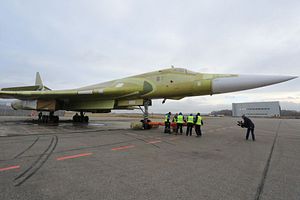The Russian Ministry of Defense (MoD) has placed an order for the first batch of ten Tupolev Tu-160M2 long-range supersonic strategic bombers with United Aircraft Corporation (UAC), the ministry said on January 25.
The signing of the contract, estimated to be worth around $2.7 billion, coincided with the first test flight of an upgraded Tu-160M2 on the same day. The bomber’s flight debut had originally been set for February 2018.
Serial deliveries of the new bomber are slated to begin in 2023, with the first aircraft expected to be handed over to the Russian Air Force by the end of this year.
The service plans to induct at least 50 Tu-160M2s at a rate of three aircraft per year beginning in 2023. Delivery of the first batch of ten bombers will likely be completed by 2027.
The Tu-160M2 is an upgraded variant of the Cold War-era Soviet Tu-160 heavy strategic bomber introduced into service in 1987 — the last strategic bomber to enter service prior to the collapse of the Soviet Union.
The upgraded version of the Tu-160 will be a completely new bomber save the aircraft’s airframe, according to Russian defense officials, although the avionics, sensors, displays, and communications systems will be similar to the Tu-160M variant, the Tu-160M2’s predecessor, according to numerous reports.
Interestingly, the Tu-160M2 bomber conducting its maiden flight last week was not an upgraded prototype, according to a Russian defense industry source.
“The plane underwent only [a] small-scale upgrade while its airframe and the engines have remained the same. Fully digitalized documentation on the new missile-carrying aircraft will be issued no sooner than the middle of this year and the work on building the Tu-160M is impossible without it,” the source said.
In reality, the Russian military aviation industry still struggling to develop a next-generation engine for the Tu-160M2, as I reported last week:
[The] Russian military aircraft industry still is having trouble with the bomber’s new engine. (…) The Tu-160M2 is expected to be fitted with the new Kuznetsov NK-32-2 turbofan engine, providing increased maneuverability and range.
(…) The Russian aircraft industry began testing a non-afterburning variant of the Kuznetsov NK-32 engine, purportedly the largest and most powerful turbofan jet engine ever fitted on a bomber, in October [2017]. The new engine will reportedly increase the new bomber’s operational range by up to 1,000 kilometers.
“This is a serious step towards developing our hi-tech sphere and strengthening the country’s ability to defend itself,” Russian President Vladimir Putin said on January 25, following the signing of the contract.
Putin ordered the upgrade of Russia’s Tu-160 force — around 16 Tu-160s are purportedly airworthy as of January 2018 — due to delays in the next-generation strategic stealth bomber project, codenamed PAK DA (an acronym for “Prospective Aviation Complex for Long-Range Aviation”).































